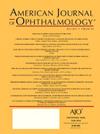Biomechanical Properties Measured With Dynamic Scheimpflug Analyzer in Myopic Maculopathy
IF 4.1
1区 医学
Q1 OPHTHALMOLOGY
引用次数: 0
Abstract
PURPOSE
Corneal biomechanical properties are associated with axial elongation. We aimed to characterize corneal biomechanical properties in highly myopic eyes with myopic maculopathy (MM).
DESIGN
Retrospective cross-sectional study.
METHODS
We included patients examined between June 2022 and August 2023 who underwent corneal visualization Scheimpflug technology (Corvis ST) measurements. MM in highly myopic eyes (axial length >26.0 mm) was evaluated using META-PM (meta-analyses of pathologic myopia) study classification based on fundus photographs with subfoveal choroidal thickness measured via spectral domain optical coherence tomography. A linear mixed model was used to analyze the association of MM features with axial length (AL) and corneal biomechanical parameters, followed by model selection using the second-order–corrected Akaike information criterion.
RESULTS
We included 189 eyes from 109 participants. A significant correlation was observed between AL and biomechanical parameters that characterize maximal corneal deformation (maximal deflection amplitude and peak distance) and stiffness parameter (stress–strain index) (P < .05). Model selection revealed that both AL and maximal deflection amplitude were independently associated with MM with category ≥2 severe, as well as with subfoveal choroidal thickness in highly myopic eyes (AL >26.0 mm).
CONCLUSIONS
In highly myopic eyes, a greater maximal deflection amplitude was identified as a risk factor for MM. Corneal biomechanical properties may serve as biomarkers for predicting the development and progression of MM.
动态Scheimpflug分析仪测量近视黄斑病变的生物力学特性。
目的:角膜的生物力学特性与轴向伸长有关。我们的目的是表征高度近视伴近视黄斑病变(MM)的角膜生物力学特性。设计:回顾性横断面研究。方法:我们纳入了2022年6月至2023年8月期间接受角膜可视化Scheimpflug技术(Corvis ST)测量的患者。高度近视眼MM(轴长> ~ 26.0 MM)的评估采用META-PM分类,基于眼底照片,通过光谱域oct测量中央凹下巩膜厚度。采用线性混合模型分析MM特征与轴长(AL)和角膜生物力学参数的关系,然后使用二阶校正的Akaike信息标准选择模型。结果:我们纳入了109名参与者的189只眼睛。AL与表征最大角膜变形的生物力学参数(最大挠度和峰值距离)和刚度参数(应力-应变指数)之间存在显著相关性(P < 0.05)。模型选择结果显示,AL和挠曲振幅最大值与高度近视眼≥2级严重MM和中央凹下脉络膜厚度(AL > 26.0 MM)独立相关。结论:高度近视眼较大的最大挠度是MM发生的危险因素,角膜生物力学特性可作为预测MM发生发展的生物标志物。
本文章由计算机程序翻译,如有差异,请以英文原文为准。
求助全文
约1分钟内获得全文
求助全文
来源期刊
CiteScore
9.20
自引率
7.10%
发文量
406
审稿时长
36 days
期刊介绍:
The American Journal of Ophthalmology is a peer-reviewed, scientific publication that welcomes the submission of original, previously unpublished manuscripts directed to ophthalmologists and visual science specialists describing clinical investigations, clinical observations, and clinically relevant laboratory investigations. Published monthly since 1884, the full text of the American Journal of Ophthalmology and supplementary material are also presented online at www.AJO.com and on ScienceDirect.
The American Journal of Ophthalmology publishes Full-Length Articles, Perspectives, Editorials, Correspondences, Books Reports and Announcements. Brief Reports and Case Reports are no longer published. We recommend submitting Brief Reports and Case Reports to our companion publication, the American Journal of Ophthalmology Case Reports.
Manuscripts are accepted with the understanding that they have not been and will not be published elsewhere substantially in any format, and that there are no ethical problems with the content or data collection. Authors may be requested to produce the data upon which the manuscript is based and to answer expeditiously any questions about the manuscript or its authors.

 求助内容:
求助内容: 应助结果提醒方式:
应助结果提醒方式:


